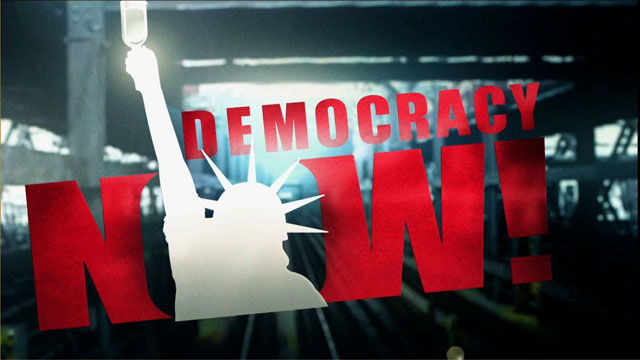
Topics
Guests
- Helen Ziacontributing editor of Ms. magazine.
- Angelo Figueroacolumnist with The San Jose Mercury News.
- Sandra Hernandezwriter for the LA Weekly.
A group of journalists participate in a roundtable discussion about the upcoming California primary. National affairs correspondent Larry Bensky goes over the major ballot initiatives, while commenting that this election has generated notably little interest among voters. Helen Zia, contributing editor of Ms. magazine, brings up an issue not on the ballot, the California Civil Rights Initiative (CCRI). Zia explains CCRI as an anti-affirmative action, discriminatory initiative misleadingly disguised as a civil rights bill. Angelo Figueroa is with The San Jose Mercury News and will soon be heading up El Nuevo Mundo, a Spanish-language version of the paper. Figueroa says that the force behind these anti-affirmative action and anti-immigration initiatives is California Governor Pete Wilson, and his actions should serve as a wake-up call for California’s Latino community. Sandra Hernandez, who writes for the LA Weekly, points out that the communities of color who have the most at stake in these initiatives also have a proportionately low voter turnout rate. All participants agree on a need for coalition-building among minority communities and the increased involvement of youth activists.
Transcript
AMY GOODMAN: And you’re listening to Democracy Now! I’m Amy Goodman. Democracy Now!, Pacifica Radio’s daily national grassroots election show. I’m joined in the studio here in New York by my co-host, Juan González, who is a columnist with the Daily News and is also author of a book called Roll Down Your Window: Stories from a Forgotten America. He is also — in the book, he has a whole section on his columns that he did out at the L.A. riots. And today, we are going out to California, because the California primary is next Tuesday, along with Nevada’s and Washington’s. But we’re going to be looking at California today with a group of California journalists. And we want to welcome everyone to Democracy Now! We’re going to begin, though, with our national affairs correspondent, Larry Bensky, who is in our — Pacific’s KPFA studios in Berkeley. Welcome to Democracy Now!, Larry.
LARRY BENSKY: Hello, Amy. Hello, Juan. Hello, everyone.
AMY GOODMAN: Good to hear you.
LARRY BENSKY: And with me is Helen Zia, who is a contributing editor to Ms. magazine. She’s with us here this morning in Berkeley.
AMY GOODMAN: And we’re also joined on the telephone by Sandra Hernandez, who is a staff writer at the LA Weekly. And we’re joined by Angelo Figueroa, who is a columnist with The San Jose Mercury News and is going to be the editor of a new Spanish version of The San Jose Mercury News, which is going to be beginning in May. And we welcome you all to Democracy Now! Why don’t we start with Larry? Larry, can you give us a rundown of the kind of ballot initiatives that are taking place that are going to be on the ballot next Tuesday in the California primary?
LARRY BENSKY: Well, there are some 11 — 12, actually, ballot initiatives statewide, but there are many more, Amy, that voters will be voting on locally, and they’re usually completely of local interest. For example, in San Francisco, they’re voting on whether or not to build a new baseball stadium and whether or not to expand the convention center so it can have bigger conventions. The propositions that have drawn the most attention, which is synonymous in California with the most money spent on television advertising, are the ones that would instill no-fault automobile insurance and limit shareholder lawsuits and lawyers’ contingency fees. And a furious battle, of occasionally very creative minds, is taking place on television these days trying to get people to vote for or against these measures, mostly for them, but somewhat against them, considering the fact that we have millions of dollars being spent on both sides.
A measure that has more political impact down the road is Proposition 198, which would allow for open primaries in the state once again. This was the system we had, somewhat similar to what we had prior to the 1950s. It would be similar to what we’ve seen in Texas and Georgia and other places, where you can walk into the voting booth on Primary Day and vote for whichever party you feel like voting for. Those who are against it, which includes every single political party in California that I know of, including the Democrats, Republicans, the Greens, the Peace and Freedom and the Libertarians, say that it would basically corrupt the process of selecting candidates from their own parties.
There are also a couple of measures about expanding the death penalty, which were put on largely for the usual hysterical reasons by opportunistic politicians in Sacramento, denying prisoners unemployment benefits, etc.
But I have to say, Amy, in general, in the 28 years now that I’ve been following California politics, since I moved out here from your great city, I’ve rarely seen — and, in fact, I think I can say I’ve never seen an election statewide that is generating so little interest, which is very ironic, because the primary was moved to next Tuesday, to March 26, in order to generate more interest, because California primaries have traditionally been held in June, and it was felt that if there was a hotly contested presidential nomination contest, which, of course, there has been, up until recently, that California would be the deciding factor. But now we have Bob Dole over the top, or nearly over the top, and so the law of unintended political consequences obtains here, just as it did in Arizona, where we reported a few weeks ago. They shifted their primary in order to give Phil Gramm a big advantage in the Republican race. And voilà, Phil Gramm had dropped out by the time Arizona primary happened. So, now we have this primary in March, and I think some of the headlines on next Wednesday are going to be, “What if they gave a primary, and nobody came?” Because we’re probably going to have an all-time record-low turnout of voters.
AMY GOODMAN: And we’re going to talk more extensively about that record-low turnout, although it varies from state to state. The fact is, the United States has one of the lowest voter turnouts, in general, of most countries in the world. And that is something that certainly is not emphasized. Why don’t we go to Helen Zia, who is at your side, Larry, to talk about something that actually is not on the ballot for next Tuesday, but is certainly of great concern to many Californians? What is its official title? Is it called something like the Civil Rights Initiative, Helen?
HELEN ZIA: Hello, Amy.
It’s called the California Civil Rights Initiative, or CCRI. Of course, its opponents call it the California Civil Wrongs Initiative. But it’s very interesting. As Larry was saying, even though there seems to be less interest in the primary, the build-up for the November vote on this California Civil Rights Initiative is really picking up steam on both sides of the — on the ballot initiative. This CCRI is a very carefully crafted, in shorthand, initiative called the anti-affirmative action initiative. And what it is, is it took the language from the 1964 Civil Rights Act on on civil rights, protecting minorities and women, and took the exact wording from President John F. Kennedy’s language, and introduced a few more phrases to it, saying that no preferential treatment would be granted to anyone on the basis of race or gender.
And in doing this, it has created a great deal of confusion among people who would normally be supportive of affirmative action. A Louis Harris poll looked at the language of this initiative and found that, as it’s stated, 81% of the electorate would vote for this initiative, in effect, repealing the provisions of affirmative action, but if it were explained to them that affirmative action would be removed, that 81% would drop to 29%.
So, in essence, what this Civil Rights Initiative will be doing is removing the protections from 1964. And so, if in a municipality the police department or fire department was all white and all male, there would no longer be recourse for anybody to look into that and say, “Well, perhaps something’s going on here, and we should look into balancing this,” or if school districts, one school district was all white and the neighboring district was all students of color, that also could not — there could be no action taken around that.
But one of the insidious things about this CCRI is that in looking at it as affirmative action, there’s a piece of it that hasn’t been addressed, which is around gender. Not only does it repeal affirmative action, but it also introduces a way to make it legal to discriminate based on gender. And what that is, they’ve introduced a little clause in there saying that for reasons of — for reasonable, bona fide provisions, anything that a municipality might come up with, it would be OK to discriminate around gender. In other words, if a fire department said, “We can’t afford to put in new lockers for any women firefighters,” that would be a bona fide provision for them to not have to bother to hire women.
So, there are a number of things in the CCRI that pretty much have thrown communities into a divided state where we’re looking at this as the language saying that it would — we will no longer have preferential treatment based on gender or race, but, in effect, is doing quite the opposite. So, there’s a great deal of confusion. And what the different communities are doing, both women’s groups and progressive groups, are really trying to go around and educate their communities so they will not think that they’re voting for affirmative action.
JUAN GONZÁLEZ: So, Helen —
HELEN ZIA: In fact, here in San —
JUAN GONZÁLEZ: Helen, in other words, this would be the opening shot in this presidential race in terms of the battle over affirmative action, which I’m sure will be an increasing issue in the next — in the coming months. To what degree, then — because out here on the East Coast, obviously, we’re not hearing very much about this, this particular initiative — to what degree are all of these civil rights organizations uniting and mobilizing people against it?
HELEN ZIA: Well, you’re absolutely right on with that question, because this, even though it’s beginning in California, it really is seen as the opening shot for the rest of the country. In fact, it was — California was very deliberately selected for that reason. And the support for this ballot initiative is coming from conservative deep pockets nationally and is seen as setting the stage for the presidential debate, because it does split the electorate up so so dramatically.
LARRY BENSKY: We should just also say, Helen, that as far as things starting in California, Juan, the measure that passed the House yesterday in Washington, the immigration bill, was based largely on Proposition 187 —
JUAN GONZÁLEZ: Yes.
LARRY BENSKY: — which passed out here, especially as far as barring illegal immigrants from public schools. And so, this is definitely seen — the CCRI on the November ballot in California is definitely seen as a national campaign by those who would repeal or limit advantages for so-called minorities.
HELEN ZIA: There is a national demonstration that is actually being focused right here in California in April, on April 14th. The National Organization of Women is trying to build a very broad-based coalition of national and statewide groups in order to focus the attention and take some of that spin, you know, around affirmative action away from the idea that the measure is for affirmative action. So, they’re really trying to create a big national build-up with groups all around the country.
AMY GOODMAN: In fact, on April 15th, the day after that march in San Francisco, we’ll be playing some of the speeches on Democracy Now! from the march in San Francisco. Speaking of immigration and affirmative action, let’s bring Angelo Figueroa and Sandra Hernandez into the conversation. Angelo Figueroa, you’re a columnist with The San Jose Mercury News. You’ve been dealing a lot with the issue of immigration.
ANGELO FIGUEROA: Yeah, you know, it’s interesting listening to what everyone is saying. You know, one of the things that I think the rest of the country needs to understand is that the governor of California, Pete Wilson, has basically been leading the charge on all these issues — immigration, anti-affirmative action. He even tried to block the motor voter law that would allow people to register to vote when they get their driver’s license.
AMY GOODMAN: Angelo, I just want to ask you to speak up as loudly as you can.
ANGELO FIGUEROA: Yes, yes. Well, I’m talking about Pete Wilson, the governor here. He’s been basically running for president for the last two years by spearheading Proposition 187 and by urging the University of California system to eliminate affirmative action considerations. And basically, now that Pete Wilson has not — was failed in his presidential bid, he’s certainly going after the second spot. He denies it, and he’ll deny it until the day he’s actually asked. But he’s co-chairing Bob Dole’s campaign here in California, and he’s continuing to battle the government over illegal immigration. He recently sued the government again regarding — he wants the government to be able to pay for the cost of jailing undocumented workers in prisons. And so, basically, a lot of what’s happening in California is definitely setting the trend for the rest of the nation. And Pete Wilson is still angling they get in the White House, one way or the other.
JUAN GONZÁLEZ: Well, Angelo, the Latino population of California is one-third of the state. Why, in the face of all of these measures, has it not been able to be mobilized in significant numbers to counter these attacks?
ANGELO FIGUEROA: Well, Prop 87 was definitely a wake-up call to the Latino community in California. And in fact, voting registration in California amongst Latinos is growing rapidly. Even here, just because of the motor voter law, here in Santa Clara County, where The San Jose Mercury News is located, voter registration amongst Latinos is up 16 to 17%. So there has been a wake-up call, and people — and the number of applications for citizenship has just been skyrocketing. In fact, the immigration service had to install new judge — get some more judges and facilities to actually process all the applications, because they were really backlogged. So, people are waking up.
LARRY BENSKY: Juan, but you also have to understand that the census figures on Latinos in California count citizens and noncitizens. So, while it may be true that 25 to 30% of the population is Latino, a much smaller percentage could register to vote legally, because they’re not citizens. And the other thing to remember is that on Proposition 187, of the Latinos who voted, what is the correct figure, Angelo? Was it 40% voted for Proposition 187, something like that?
ANGELO FIGUEROA: Yeah, which was — yeah, there was — I don’t think it was that high, but there was a significant number of Latinos who, in fact, did vote for Proposition 187. And it’s a really interesting thing, where immigrants come in, and they’ve been here for several generations, and suddenly they kind of — some people forget where they came from, and they suddenly want to close the door on everyone behind them.
AMY GOODMAN: Let’s bring Sandra Hernandez into the conversation, a staff writer with the LA Weekly. What areas of California do you cover, Sandra?
SANDRA HERNANDEZ: I work primarily with communities of color. I work — I cover areas such as South Los Angeles and East Los Angeles and so forth. So, those are — those are the communities that I’ve worked with. And it’s interesting, what I’ve heard this morning, because I think that a lot of — a lot of the support that people and enthusiasm that people are trying to draw on is very similar to what we saw during 187 — that is, the low-propensity voter. You’re trying to bring out the African American community, the Latino community to vote on some of these issues, because, certainly, as everybody has pointed out, immigration, the Civil Rights Initiative, all these things are things that are going to be setting the tone for the country. But it is often difficult for it to resonate in these communities, because people feel very dislocated from these issues oftentime. I think immigration is — I spoke to somebody yesterday who heads up a immigrant rights group, and they were talking about, really, that in this election, immigration is one of the fundamental issues for Latinos. But many, as people have pointed out this morning, are not in a position to vote, or don’t. I mean, the majority of California’s voting bloc is still white. So, I think that, you know, it’s interesting to see how these issues will be played out, because even though you’re going to see more of — more Latino voters, people estimate that there’s a 10-year lag time in terms of when the Latino political power will be catching up.
AMY GOODMAN: You know, talking about who is voting, I was just looking at some figures that even while most of the people who vote in California may be white, only 7.4% of those old enough to cast votes actually did so in Republican presidential primaries so far anywhere in the country. Seven-point-four percent of Republicans who could vote have been voting.
ANGELO FIGUEROA: I think that’s a good sign. I just think that there’s not a lot of interest in the Republican presidential candidates. None of them, I think, have been able to actually stir the electorate, the conservative voters. Here in California, a poll was just published that shows that Clinton would beat Dole — and Dole, who’s expected to win the primary easily — is expected to beat Dole by a margin of 55%, over 39% more in a poll that was taken. And it’s, I think, the biggest — the biggest hope that a lot of Republicans have is that Colin Powell joins the race as part of the ticket with Dole. And that was certainly [inaudible] —
LARRY BENSKY: Well, but there’s a — there’s another possibility, too, which people are beginning to talk about, which is that Ralph Nader, who’s already said he’s going to be on the Green Party ballot here in California — and by the way, the Green Party is a qualified party, so they don’t have to go out and get signatures. They are on the ballot. And if they nominate Ralph Nader, which they’re expected to do within the next two weeks, he’s on the ballot as a presidential candidate. He automatically gets 5%, and maybe as high as 10% or more, of the people who will vote, according to every poll I’ve seen. Then you have the possibility of Ross Perot announcing tonight on The Larry King Show, and he’s going to be on the ballot in California, too. Both of those candidates take from Clinton, Perot much more this time than he did last time, because now he’s running against an incumbent, just as he did against George Bush in 1992. He will hurt Clinton much more in California than he did last time. So, it’s not a cake walk for Bill Clinton over Bob Dole in California — far from it — in November.
AMY GOODMAN: Larry, we’re going to break, and then we’re going to come back and continue this journalist roundtable, particularly focusing on journalists from California. Helen Zia is our guest in San Francisco, contributing editor at Ms. magazine; Sandra Hernandez, LA Weekly; Angelo Figueroa, San Jose Mercury News, starting up a new paper, which we’ll talk about; and Juan González, here in New York, from the New York Daily News. I’m Amy Goodman. We’ll be back after this break.
[break]
AMY GOODMAN: You’re listening to Democracy Now!, Pacifica Radio’s national grassroots election show. I’m Amy Goodman. Joining me here in New York, Juan González of the Daily News, who was out covering Los Angeles during the L.A. riots and has covered extensively what’s going on around the country with Latinos, just finishing his book on Latinos in America. And again, as I said, in California, we’re joined by Larry Bensky and Helen Zia in San Francisco — Larry, Pacifica’s national affairs correspondent; Helen, who is particularly focusing on the so-called Civil Rights Initiative for Ms. magazine. And we’re joined by Sandra Hernandez, LA Weekly staff writer, and Angelo Figueroa, a columnist with The San Jose Mercury News. Angelo, I wanted to ask you about this new newspaper you’re going to be editor of.
ANGELO FIGUEROA: Yeah, it’s called Nuevo Mundo. Excuse me. It’s called Nuevo Mundo_. It’s a weekly newspaper. And it will — _The San Jose Mercury News is actually the first major metropolitan newspaper in the Bay Area to come out with a Spanish-language newspaper. So I’m real excited about it.
AMY GOODMAN: Why did they feel the need, The San Jose Mercury News, to have a paper in Spanish?
ANGELO FIGUEROA: You know, there’s been a whole lot of debate in this state about English only and immigration and all these other issues, and yet, you know, Spanish is the second language of California, and it’s the second language of the United States and will continue to do so.
AMY GOODMAN: Don’t let Pat Buchanan hear that.
ANGELO FIGUEROA: Well, he’ll just have to live —
LARRY BENSKY: He knows.
ANGELO FIGUEROA: He’ll just have to live with it. But the demographics in Northern California are changing rapidly, and Latinos will make up 30%, a total of 30%, very, very soon, within the — by the year 2000. So, the paper is just really going out to reach out after new readers.
JUAN GONZÁLEZ: Well, Angelo —
LARRY BENSKY: Is this a daily?
ANGELO FIGUEROA: Pardon me? No, we’re talking about a weekly.
LARRY BENSKY: Excuse me, Juan. I want —
ANGELO FIGUEROA: No, we’re talking —
LARRY BENSKY: Oh, it’s a weekly. And is it — is it going to be distributed free or paid? Or how is it going to be distributed?
ANGELO FIGUEROA: Yeah, it’s going to be a free — free in separate racks, in news racks, and also subscription for people who do want it delivered to their homes.
AMY GOODMAN: Juan, the Daily News tried this, a daily Spanish version of the Daily News.
JUAN GONZÁLEZ: Oh, right. That’s why I wanted to wish Angelo luck with that, because the New York news here tried that beginning last June, and it lasted for about seven months, and then they folded the newspaper. I think that the formula that they developed, which was a completely bilingual newspaper, was an impediment, but I think that, basically speaking, they were not able to put the resources behind it. So I hope that The Mercury News, which I know is part of the Knight Ridder newspaper chain, second-largest newspaper chain in America, probably has some resources, although they’re still battling that Detroit strike, so they’re losing a lot of money in the Detroit strike. But I hope that they put the kind of resources behind it that will enable you to succeed.
ANGELO FIGUEROA: Right. They are, I think —
LARRY BENSKY: They also have a precedent — there’s also a precedent — excuse me — in Knight Ridder, the company that owns The San Jose Mercury News, with the Miami Herald, which has published for over 10 years now, maybe 15 years, El Nuevo Herald, which is a daily Spanish version of the Miami Herald. And this is an intriguing political point, Angelo, which I wonder if you have any thoughts about. El Nuevo Herald in Miami has been, of course, a Cuban American-centered paper down there, extremely right wing in its views, especially, of course, towards Cuba. The Mexican American community, which is largely the Latino community in Northern California, is not as reactionary in its views by far, in fact could be said to be progressive politically in its views. Do you think that by having your newspaper and the columnists and writers you’ll have for it, you might bring The San Jose Mercury News and its satellite papers up here to a more progressive point of view about issues?
ANGELO FIGUEROA: Yeah, well, you know, I think newspapers, to a certain degree, or to a large degree, represent the areas where they work or where they publish. And certainly in Miami, it’s very difficult to run a Spanish newspaper unless you’re anti-Cuba and anti-Fidel Castro. I think here at The Mercury News, it’s a totally different environment. We are — the primary number of Latinos here are Mexicans and Mexican Americans, and that’s the community we’ll be talking to. So, yeah, I suspect it will be a lot more progressive on a number of issues.
AMY GOODMAN: Tell me, will it change, do you think, the way you write? For example, Sandra, you are at the LA Weekly. You’re really the eyes and ears of the Latino community for a white audience. How does that feel?
SANDRA HERNANDEZ: Well, I think that, first of all, I’d like to congratulate Angelo, because it’s at a time when, here in Los Angeles, La Opinión, which is the Spanish-language newspaper, has now been — it’s now distributed via mail, sort of threatening its position. I’m glad to hear that these other newspapers are springing up, because it’s very important, especially for the Latino community.
In terms of covering Latino issues here in Los Angeles, I think it’s still often, as it is with the African American community and certainly for Asian reporters, as well, one is in a position of explaining these communities, because they still are perceived as sort of being the other, even though in Los Angeles Latinos are so much a part of daily life here. So, it is — it’s interesting in terms of being asked, for example, to explain immigration issues, ABC, the whole gamut, and why the — why, for example, the new green cards cause such a stir and concern in the Latino community, because so many people could potentially be left out. So, these are the types of issues, as well as, for example, you know, bridging the — bridging the distance between, for example, the African American community and the Latino community on some issues. And —
JUAN GONZÁLEZ: Sandra, I’d like to ask you to take off from that, in terms of the relationship between the African American and the Latino community and the Asian community in Los Angeles, and the ability to unite the groups, for instance, around this opposition to this anti-affirmative action proposition now that’s on the ballot. Are there still tensions or difficulties that have not been overcome or have not been surmounted in terms of building the kind of unity that would be necessary for a progressive movement in L.A.?
SANDRA HERNANDEZ: I think that, interestingly enough, you are seeing a lot of the same coalitions that came out of, for example, Proposition 187.
JUAN GONZÁLEZ: Even though the majority of African Americans and about 30% of Latinos voted for that?
SANDRA HERNANDEZ: Mm-hmm, exactly. But a lot of the coalitions that sprang up to oppose that were multiethnic coalitions. You had, for example, coalitions with the Southern Christian Leadership Conference here in Los Angeles and across the board. I think that the problem — and it’s interesting, because just recently a group called the Multicultural Collaborative released a report that said, you know, that in Los Angeles, many issues of race are still handled and interpreted on a crisis-by-crisis issue, so that, really, there is still not this broader coalition building, and there’s still these very isolated pockets where groups spring up and deal with these issues. I think, with affirmative action, certainly, I know in South Los Angeles, there have been coalition groups that have sprang up and are working on this and hold, for example, a lot of youth summits and are working with a lot of the young people. But the problem there is more of a generational gap than across ethnic lines.
AMY GOODMAN: Speaking about crossing — speaking about crossing racial lines, let me bring Helen Zia into the conversation, from Ms. magazine. You’ve been looking at the San Francisco march, Fight the Right, that is going to be taking place on April 14th. Now, I hear that the NAACP has not endorsed, although it is focusing on affirmative action. Is that right?
HELEN ZIA: That’s true. The NAACP has not yet endorsed. There’s a lot of discussion going on. And I think it’s very, very interesting what Sandra was just saying about the coalitions reforming after Prop — the loss in Proposition 187. I think there has been a great deal of soul searching going on here in California among these groups as to why Proposition 187, they were not able to defeat that measure. And there’s a lot of discussion going on to not repeat that in this CCRI vote that’s coming up. So they may actually be the same groups and same formations.
But, for example, this demonstration on April 14th is being called by the National Organization of Women. There are issues, you know, about, for example, why should gays and lesbians be in support of this march that is primarily around affirmative action. What about getting the Asian American vote out there and in strong numbers to show that Asian Americans, you know, will not be used as a wedge in this issue? Because the issues of immigration and affirmative action have successfully also divided these groups and haven’t run out — brought out a unified showing. So, with this march on April 14th against CCRI, there’s really an all-out attempt to build across those bridges, so that a group like National Organization can also get a group like the NAACP to join with it, even though they might not agree on all of the issues involved in the demonstration.
LARRY BENSKY: And, Amy, I should say, and I think Sandra Hernandez probably also noticed this, that in the anti-187 fight, something came out in California which we hadn’t seen for years, and that is a very strong youth component.
SANDRA HERNANDEZ: Yes.
LARRY BENSKY: Youth are really the least-regarded minority in the electoral system in the United States, and this is because of statistics like only 15% of people between the ages of 18 and 24 voted in 1994, the election that gave us the wonderful Republican Congress. Only 15% of people 18 to 24 voted. And because they don’t turn out in any substantial numbers, they are disregarded by the political system. This was not true in the anti-187 movement, and I suspect it’s not going to be true in the anti-CCRI movement. And so you’ve got a component here that is clearly easier to mobilize, in the sense that their enthusiasm is easier to kindle on college campuses, on even high school campuses, to get young people mobilized in an area like this. This could, of course, also help the top of the ticket, Bill Clinton and the others running for the California Legislature this November. But I think that that’s a factor that’s going to have to be looked at in the African American community and the Latino community especially, young people’s involvement, which in many cases also gets a lot of parents involved who might not otherwise be involved.
ANGELO FIGUEROA: That’s right. There actually was a tremendous amount of youth involvement in the anti-187. But back to an earlier point, there is — you know, minorities here in California and a variety of groups can unite under certain issues. And I certainly think that the anti — the Civil Rights Initiative is something that’s uniting a lot of people. On the other hand, as Juan mentioned, there are major problems between the Black — the African American community and the Latino community in Los Angeles, major problems between the way Asians in California view certain issues as opposed to other minority groups. And certainly, there is a lot of work that needs to be done in that area.
You know, a lot of people don’t realize — and, Juan you were in L.A., and I remember seeing you during the riots and in a couple other cases there. But you were in L.A., and you know that in the Black community, when we talk about South Central Los Angeles and other communities, like Watts and Compton, those communities are almost split, in terms of the number of African Americans and Latinos who live there. And more and more immigrants, as they’ve come, those are the communities where they’re living, and it has created tensions. There are a lot of African Americans who feel that they’ve taken away the few jobs that are available in those areas. And so, there are a lot — there’s a lot of work that needs to be done in the area of coalition building amongst various groups.
JUAN GONZÁLEZ: And it’s almost part of the nature of American society and the continuing immigrant experience that the ruling powers in the society are able to continue keeping people divided, as the old immigrants then turn against the new immigrants. And these class — these divisions within working people and the poor continue to be repeated over and over again. Just the the ethnic group or the racial group or the religion change, but the basic divide-and-conquer process continues.
AMY GOODMAN: You know, I wanted to ask Angelo and Juan this question. Here we are at a journalist roundtable right before the California primary. You two started out in the same organization, in Young Lords, the kind of, in some ways, equivalent of the Black Panthers of Latinos — you, Angelo, in Detroit, Juan here in New York, in the Bronx and East Harlem in Manhattan. Do you feel like you’re accomplishing the same things as journalists that you were doing back then?
ANGELO FIGUEROA: I certainly do. I don’t think I’ve necessarily changed dramatically. You know, they say you get a little older, you become a little bit more conservative. No, I think that the same — the same issues — we’re still fighting the same issues, and we’re just doing it at another level. And at the same time, I think — and I know I speak for Juan, as well — helping to bring in a lot of other people into this conversation.
JUAN GONZÁLEZ: Yeah, and, well, I think that, generally speaking, I continue to basically, in my coverage and in my work in journalism, try to do the same thing I was doing many years ago, which is educate the public to be able to effect the kind of change that they want in the society.
ANGELO FIGUEROA: You know, one of the things that I think is really important is that a lot of the issues that are being played out in society are also taking place in newsrooms. I mean, we’re still struggling to get more minority journalists in newsrooms. If you walk into a few newsrooms in San Francisco, you would not believe that you were in San Francisco. I mean, they look nothing like the city. And almost 50% of all newspapers in the country don’t have one minority employee. So, it’s still — a lot of these same issues are still here, and we’re fighting them in the newsrooms, as well.
AMY GOODMAN: Is anyone following — let me ask you a quick question, as we’re about to go out. There’s a very close relationship between the Gallo family and Bob Dole. They’ve poured a lot of money into his campaign. And Bob Dole has, in turn, passed, pushed through some legislation that particularly helps the Gallo family. In California, what does this mean to the communities you cover, Angelo, Sandra, Larry?
LARRY BENSKY: Well, actually, it means —
ANGELO FIGUEROA: Actually, you know, I wasn’t aware of that. I like that. I like the way you phrased that, that they’re pouring a lot of money into Dole’s campaign. I wasn’t aware that, but I wouldn’t be surprised if — you know, the wine industry is huge here in California and employs, especially up here in Northern California — and employs literally thousands of Latino farmworkers. I really — I can’t really talk a lot about that, but it’s interesting, and I will certainly look into that.
LARRY BENSKY: Well, the wine industry also takes out an enormous amount of commercials on television, and Gallo especially, and in newspapers. And campaign finance, in general, is covered episodically, spasmodically, inadequately and inaccurately in the media. And this is a tremendous scandal here in California, as it is nationwide. The fact that almost nobody knows about that connection, if they didn’t read Charles Lewis’s book or listen to Pacifica Radio, I think, is pretty symptomatic.
AMY GOODMAN: There’s an interesting generation tax that he was able to pass, Bob Dole, that affected something like only 5% of the richest Americans, and particularly was believed to be targeted at the Gallo family, where they could pass back inheritance, not to their children, but to their grandchildren. So it only benefited large families with large numbers of grandchildren, passing on large inheritances. We’ll talk more about that and campaign finance reform. In fact, on Monday, Larry and I are joining in a conversation with California Common Cause, that has put a ballot initiative on the ballot around campaign finance reform, and Californians Against Political Corruption, who have a competing ballot initiative that’s not yet on, although they’d like to see it on. It’s a bit more radical than that of California Common Cause. It’s an interesting debate. We’ll be doing it on Monday.
I want to thank everyone very much for joining us: Helen Zia, contributing editor to Ms. magazine out in — based in Oakland; also, Sandra Hernandez, staff writer at the LA Weekly; Angelo Figueroa with The San Jose Mercury News, and soon to be, the name of your newspaper? The new paper?
ANGELO FIGUEROA: El Nuevo Mundo.
AMY GOODMAN: El Nuevo Mundo. And we look forward to seeing a copy of that in May. Juan González, thanks for joining us here in New York from the New York Daily News and co-host here at Democracy Now! And, of course, Larry Bensky also co-hosts, Pacifica national affairs correspondent. The conversation continues.
Democracy Now! is produced by Julie Drizin. It was engineered in New York by Matthew Finch, our director, Errol Maitland. And we encourage you to write to us by email. And let me say, if you have written and haven’t gotten too much of a response, we are inundated with letters — well, whatever you call email. And we certainly will be responding soon. So, keep the mail coming in. Let us know what you think. We are at democracy@pacifica.org. That’s democracy@pacifica.org. If you’d like a copy of today’s program, you can write to us at 1-800-735-0230, make a call. I’m Amy Goodman for Democracy Now! Thank you very much for listening.
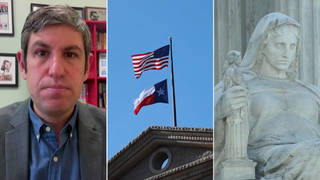
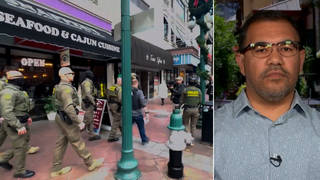
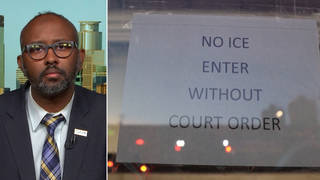
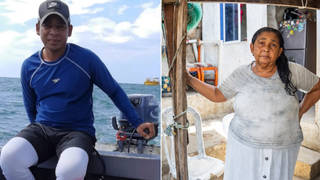

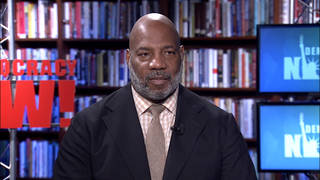
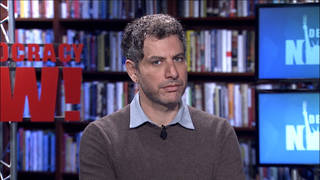
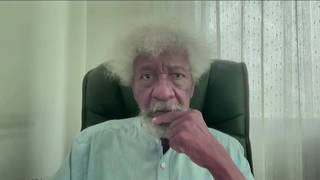
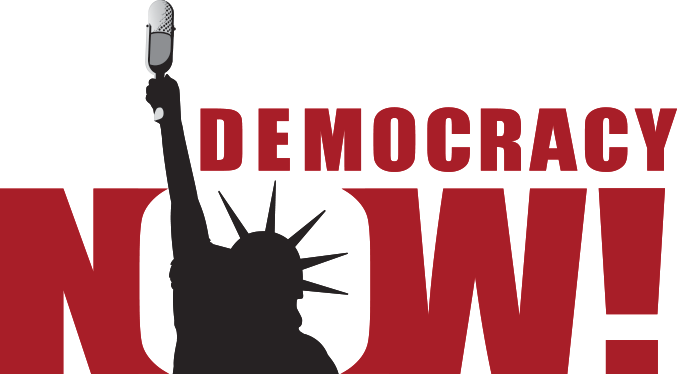

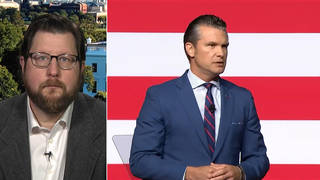
Media Options